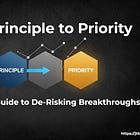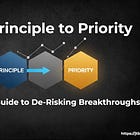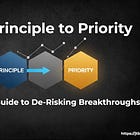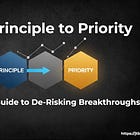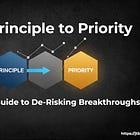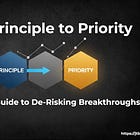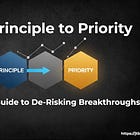From Principle to Priority: Chapter 2
The Antidote: Innovation as Staged, De-Risked Option
This 10-article series is designed to disrupt common thinking about innovation. It provides a new framework to help you tear down old methods and invest more efficiently in breakthrough ideas. Please share!
The alternative we need does not require us to invent a new financial language. It simply requires us to apply an existing, proven, and powerful financial concept to the work of strategic innovation. That concept is Real Options Analysis (ROA).
This idea, born in the world of high-finance, provides the antidote to the Monolithic Fallacy. It gives us a rational, sophisticated, and defensible way to invest in uncertainty. It does this by fundamentally reframing the goal. Instead of a single, binary “bet,” innovation investment becomes a staged process of “option buying.”
Let’s start with a simple financial option. When you buy a stock option, you are not buying the stock itself. You are buying the right, but not the obligation, to purchase that stock at a fixed price at some point in the future. You pay a small premium today to secure a future decision. If the stock price soars, you “exercise” your option and reap the massive upside. If the stock plummets, you let the option expire, and your total loss is capped at the small premium you paid.
A real option applies this exact logic to tangible, real-world strategic decisions.
An innovation project is not a monolithic bet. It is a bundle of options. A small R&D investment today is not a “cost”; it is the “premium” you pay to purchase an extremely valuable option: the option to build, scale, and own a new market in the future.
This mental model fundamentally changes everything. It shatters the illusion of certainty and replaces it with the logic of staged investment. The goal is no longer to be “right” in a five-year forecast. The goal is to pay the least amount possible to buy the next option.
When you adopt a Real Options framework, the core question at every funding gate changes.
The old question was: “Can you prove this will work and generate a 30% ROI?”
The new question is: “What is the single biggest uncertainty that, if left unanswered, will kill this project? And what is the smallest, cheapest, fastest experiment you can run to generate the data that resolves that uncertainty?”
This is how we de-risk exploration. We don’t fund a five-year, $50 million plan. We fund a three-month, $50,000 experiment. That $50,000 isn’t a bet; it’s the premium for an option. It buys us the right to make a smarter decision in three months. At that point, we don’t just have opinions; we have data. We have hard-won evidence. And with that evidence, we can make our next, more informed investment.
This framework is built on five core types of options that are always present in an innovation project:
The Option to Defer: The right to delay an investment until more information is available or the market becomes more favorable.
The Option to Expand: The right to scale up a project, entering new markets or adding new features if early results are promising.
The Option to Contract: The right to shrink the scope of a project if it’s not gaining traction, saving capital that would have otherwise been wasted.
The Option to Abandon: The right to kill a project with minimal losses if it proves unviable. In a traditional monolithic model, this is seen as a “failure.” In an options model, it is a “success”—a smart decision to let a worthless option expire, saving the company from a catastrophic loss.
The Option to Switch: The right to pivot the entire approach—the technology, the market, the business model—based on new learnings.
This is the strategic and financial “wrapper” for our entire innovation process. It provides the governance model, the funding mechanism, and the mental framework that allows exploration to thrive inside an organization built for execution.
This journey, from a vague hypothesis to a fully-scaled business, can be broken down into three distinct macro-bets, three major options that we must purchase in sequence.
The First Bet: The Option to Explore This is our first, smallest investment. The business case question is simple: “Is this a real, valuable, and unsolved problem for a specific group of people?” The goal is not to build a solution, invent a technology, or write a line of code. The goal is to conduct qualitative research to confirm that the problem is real. This investment is the premium we pay for the Option to Explore.
The Second Bet: The Option to Validate Once we have confirmed a real, qualitative problem, we must ask: “Is this problem big enough to matter? Can we quantify the struggle and identify a critically underserved segment of the market?” This is a larger, but still contained, research investment. We move from qualitative interviews to quantitative surveys to size the opportunity and, crucially, prioritize the most significant unmet needs. This investment is the premium we pay for the Option to Validate.
The Third Bet: The Option to Build Only now, armed with qualitative validation of the problem and quantitative data on the opportunity, do we finally earn the right to talk about a solution. The final bet is to design and run an experiment—a true Minimum Viable Test—to answer the question: “Does our solution concept actually get the job done better for the customer in a real-world context?” This investment is the premium we pay for the Option to Build & Test.
This three-part journey—Explore, Validate, Build—is the structure of this almanac. It is the practical, step-by-step methodology for moving an idea from a spark of insight to a de-risked, defensible, and scalable business. And it all begins with the first tool, the one required to buy our very first option. It begins with deconstructing the problem itself.
Guide to the Series
I make content like this for a reason. It’s not just to predict the future; it’s to show you how to think about it from first principles. The concepts in this blueprint are hypotheses—powerful starting points. But in the real world, I work with my clients to de-risk this process, turning big ideas into capital-efficient investment decisions, every single time.
Follow me on 𝕏: https://x.com/mikeboysen
If you’re interested in inventing the future as opposed to fiddling around the edges, feel free to contact me. My availability is limited.
Mike Boysen - www.pjtbd.com
De-Risk Your Next Big Idea
Masterclass: Heavily Discounted $67
My Blog: https://jtbd.one
Book an appointment: https://pjtbd.com/book-mike
Join our community: https://pjtbd.com/join



